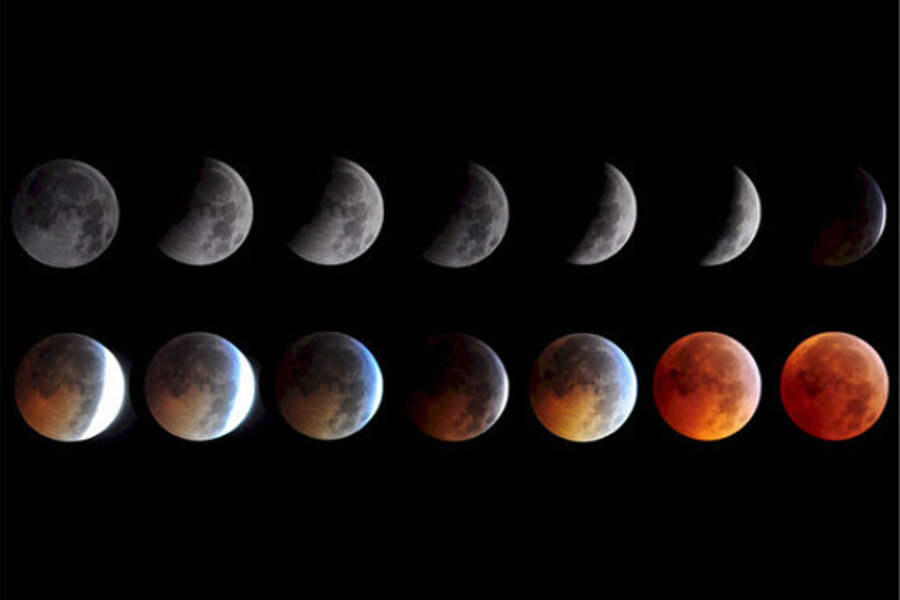Penumbral lunar eclipse Friday: So what's a penumbral eclipse, anyway?
Loading...
Friday's lunar eclipse will be the least dramatic of the three kinds of lunar eclipse: total eclipse, partial eclipse, and penumbral eclipse.
What's the difference? Location, location, location.
Total lunar eclipse
In a total lunar eclipse, like the one seen in the picture above (see a bigger version here), the sun, moon, and Earth are perfectly aligned, and the Earth's shadow completely covers the moon. As the eclipse starts, and the three bodies are moving into perfect alignment, the Earth's shadow sweeps across the moon's face until it is totally darkened, at which point the moon appears to have an unearthly reddish color, due to the sunlight filtering through Earth's atmosphere and painting the moon with a sunset-red glow. That lasts a few minutes or hours, depending on the Earth's and moon's orbits, and then the Earth's shadow sweeps off the moon.
Partial eclipse
During a partial eclipse, the Earth is just a smidge out of alignment with the moon and sun. This results in only a piece of the moon getting hidden by Earth's shadow, so observers from Earth see a round notch "missing" from the full moon, leaving a shape like a cookie that's been bitten.
Penumbral eclipse
Penumbra comes from the Latin for next-to-the-shadow, because the moon will be only slightly shadowed. During a penumbral eclipse, the sun, moon, and Earth are a bit further out of perfect alignment than in a partial eclipse, and suddenly it matters that the sun doesn't produce a pinpoint of light, like a laser, but a huge, broad beam, like a floodlight a million miles across. During a penumbral eclipse, the sunlight is partially blocked, but not enough to cast more than a smudge of a shadow. Imagine someone holds up a basketball in front of a floodlight. Sure, you'll block some light, but not enough to make a lot of difference.
During Friday night's penumbral eclipse, don't expect to see a cookie-bite out of the full moon, let alone a totally darkened and reddish moon. In fact, you won't see anything unless you look within a few minutes of the maximum effect, which is happening at 7:51 p.m. EDT. At that point, you'll see a shadowy smudge, like the top left image in the picture above. On Friday night, that smudge will affect the southern half of the moon. You can get a good idea what to expect from these pictures, taken during last November's penumbral eclipse.
Are penumbral eclipses safe to watch? Do I need special equipment?
Lunar eclipses – of any variety – are perfectly safe to watch with the naked eye. Solar eclipses are dangerous because even though it feels dark, the sun's radiance can still damage your eyes. Since you wouldn't stare at the sun when it's bright, you also shouldn't stare at the sun when it's darkened. But you can gaze at the moon any time you want, for as long as you like, without harming your eyes – eclipse or no eclipse. Binoculars or telescopes can help you see more details, but aren't necessary.
Who gets to see the eclipse?
The best observing will be in Brazil, Europe, or anywhere in Africa.
Unfortunately for most people in North America, the moon will be most deeply shadowed at 7:51 p.m. EDT, so only people on the East Coast will have a good chance to see it. In the Midwest, the eclipse will happen shortly after sunset and moonrise, when the moon is faint against the dark blue twilight sky, and subtle light changes probably won't be visible. People in the western states won't have any chance to see it, since the eclipse will begin and end before the moon rises.








